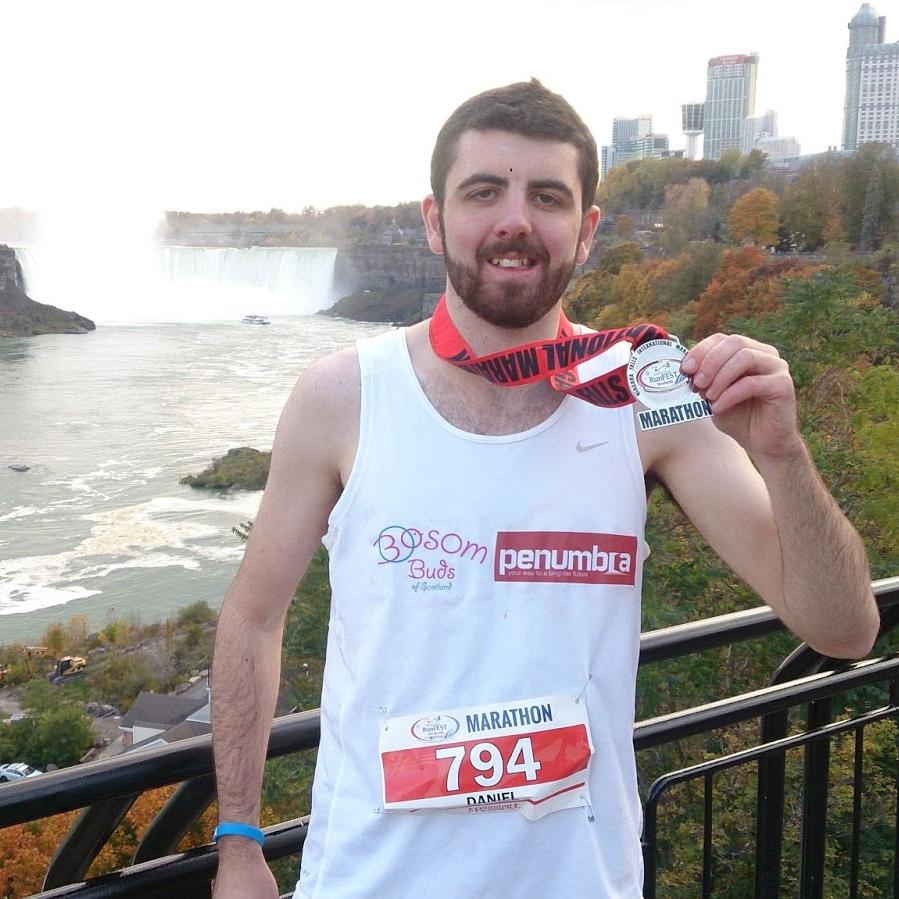Who’s faster? The Ultimate State Comparison for Marathons
For this study, we analyzed 19.6 million results from over 16 thousand marathon races.
We recently published our mega-study on the state of running, where we found that the world, and in particular, the marathoners from the US are getting slower. We became curious to see how the 50 individual states +D.C. are performing.
Feel free to use any material from this page, as long as you refer to this original source.

We've also created a tool that can help you compare your race results to your fellow Americans.
State finish time rankings
Overall rankings
The fastest state in the US is Massachusetts with an average finish time of 4 hours 4 minutes 20 seconds. Washington comes second with an average finish time of 4 hours 18 minutes 9 seconds and Indiana is third (4 hours 18 minutes and 57 seconds). The three slowest states, in that order, are - Alaska (5 hours 30 minutes), Florida (5 hours 33 minutes) and Hawaii (6 hours 16 minutes).
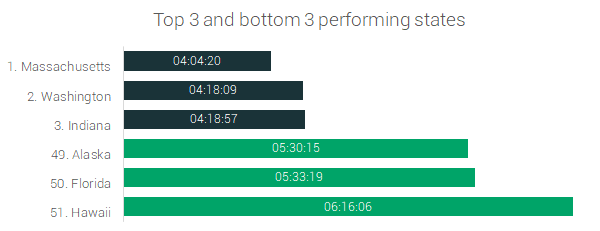
Full rankings by finish time
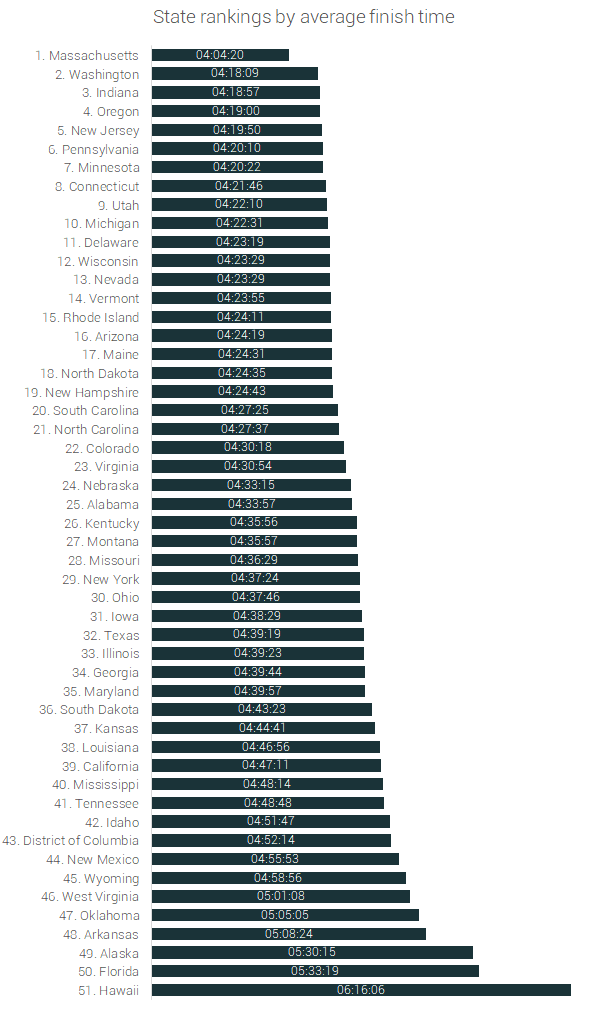
Female rankings
The best women in the country are the ones from Massachusetts, with an average time of 4 hours 15 minutes 1 second. The slowest are from Hawaii with an average finish time of over 6 and a half hours.
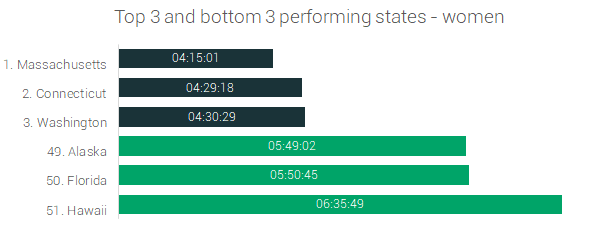
Women from Massachusetts are faster than men from 36 states + DC. They include - New York, California, Nevada, Vermont and many many more.
Full rankings by finish time - women

Male rankings
The fastest men are again from Massachusetts, with an average of 3 hours 54 minutes. The slowest men are from Hawaii, with an average of just under 6 hours.
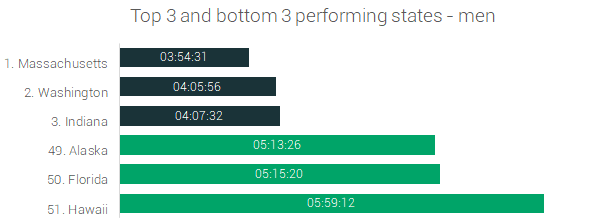
Full rankings by finish time - men
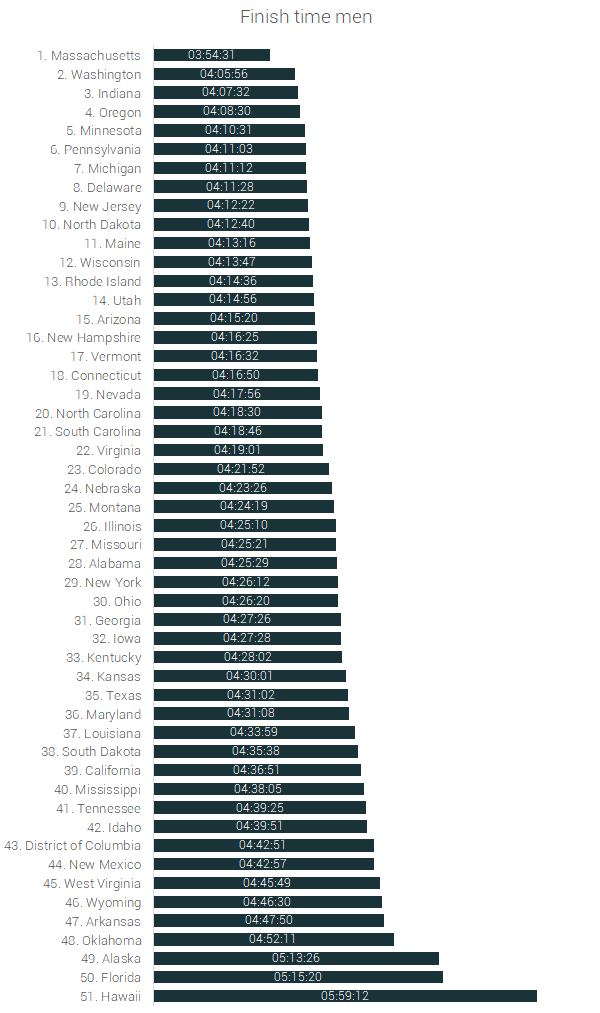
Over the last 10 years, some of the states have improved and some of them have slowed down. The most improved is New Mexico - they have shaved off more than 27 minutes of their average time. On the other hand, the biggest slow down is the one of Florida - they have added more than 40 minutes to their average time.
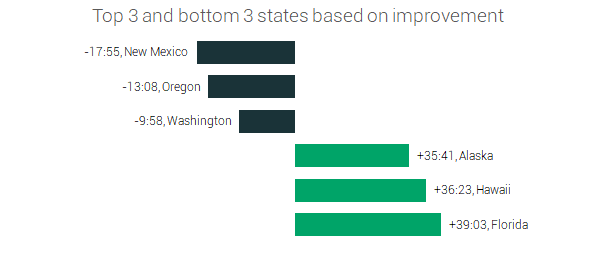
In total, just 12 states have improved over the last 10 years. The other 38 + DC have slowed down.
Full rankings by the change in finish time
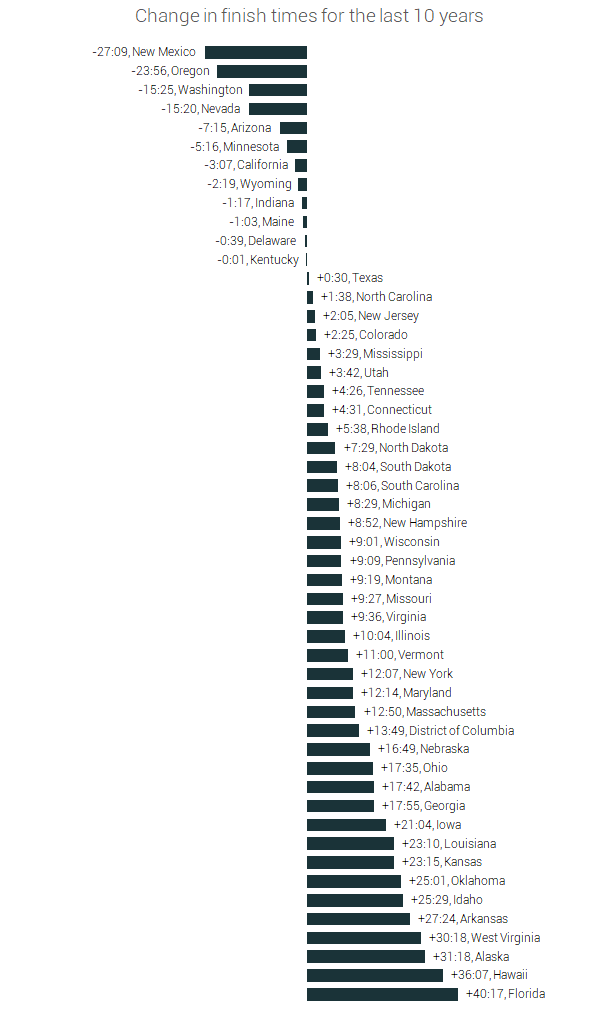
The women from New Mexico have improved most, and they have improved more than the men. The women from just 15 states have improved over the last 10 years, which is still more than the average.
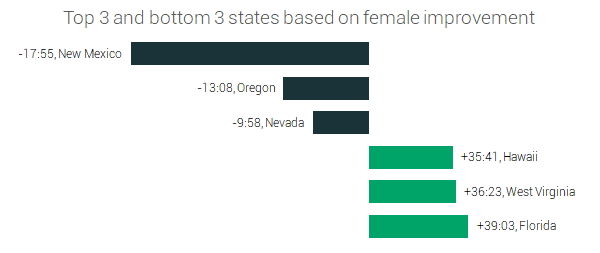
Full rankings by the change in finish time - women
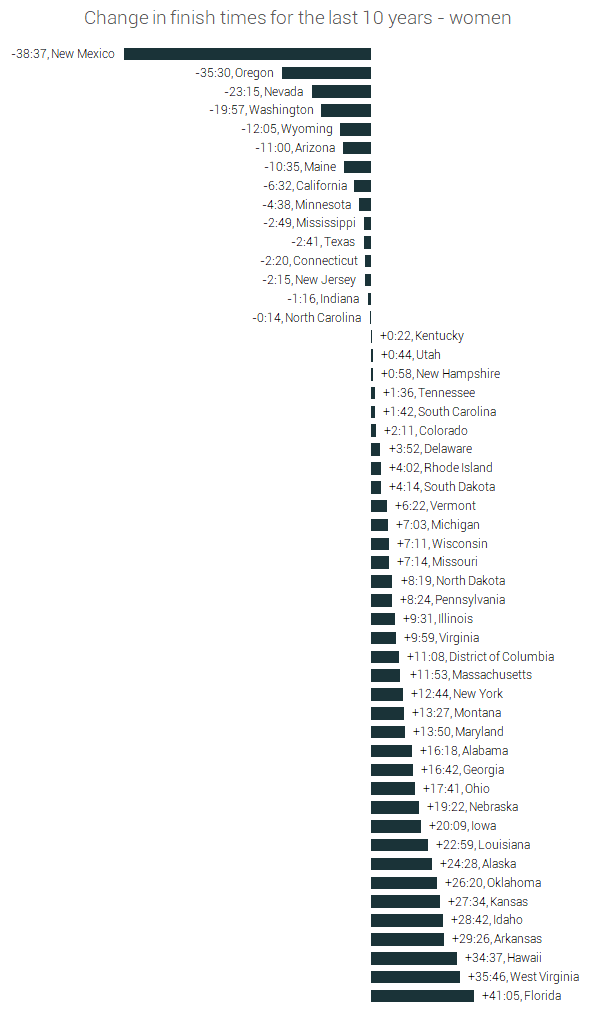
Men have slowed down on average more than women. And even the ones who have improved have improved less than women.

The men from 10 states have improved, the rest have slowed down.
Full rankings by the change in finish time - men
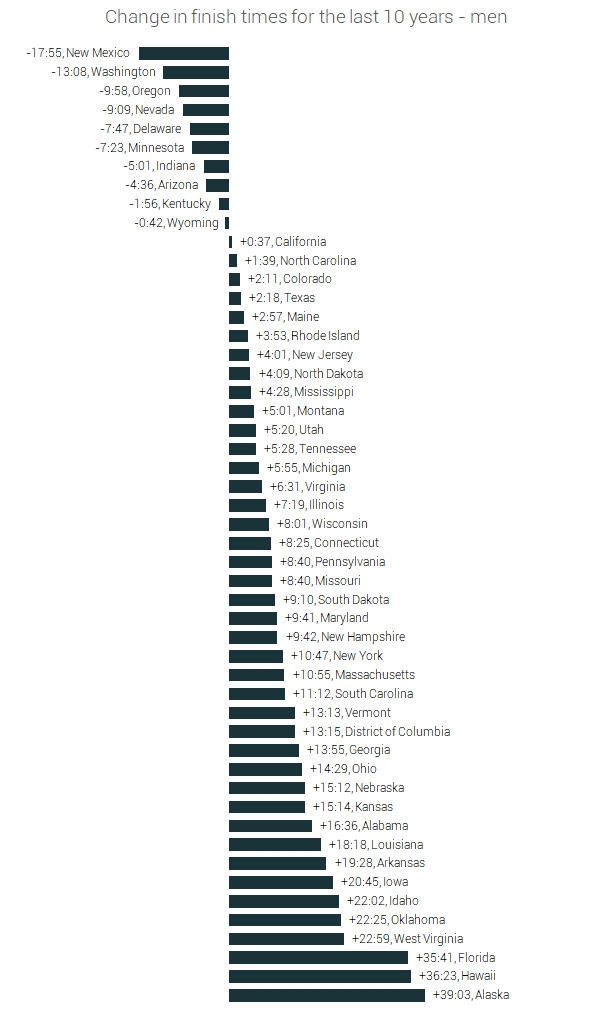
Participation
The states with the biggest % of all marathoners are New York, California, and Illinois. And the states with the least are Idaho, Wyoming, and Alaska.
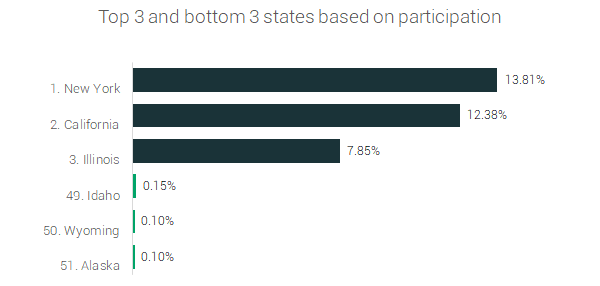
Full rankings by number of participants
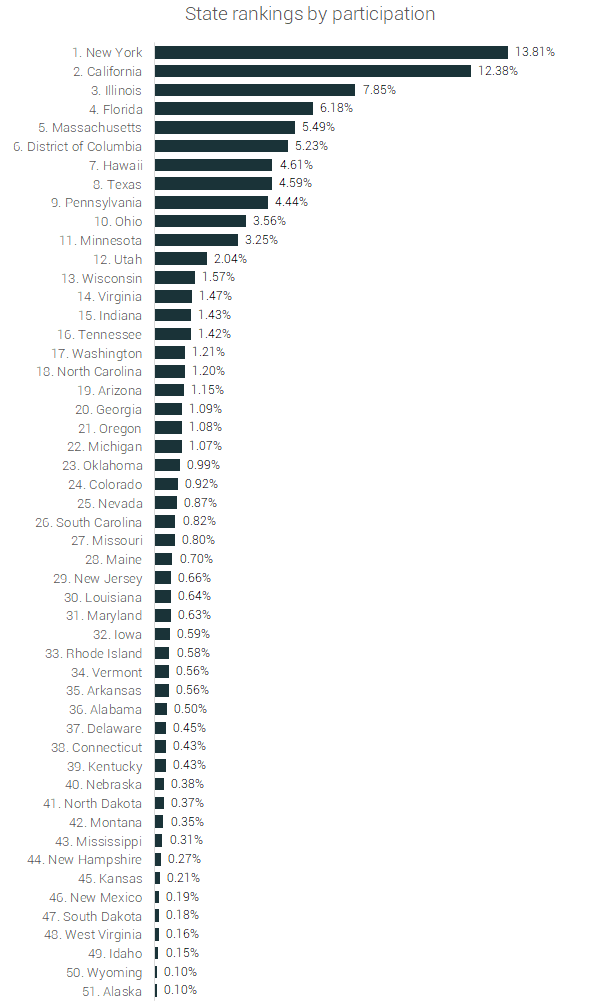
These numbers look different when we look at the number of participants as a proportion of the state population. The 'state' with the highest percentage of people strapping on their running shoes to complete marathons is Washington DC.
Here we see that the states with the biggest proportion of runners are DC, Hawaii, and Vermont. And the ones with the least are West Virginia, New Jersey, and Kansas.
The overall rate of marathon participation is 0.13% of the US population.
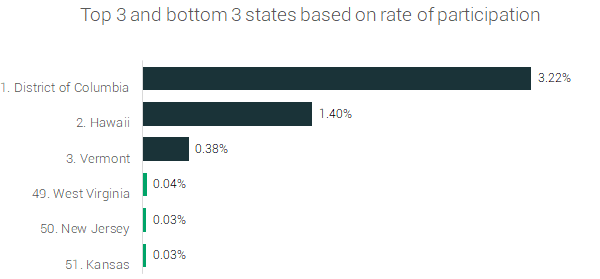
Full rankings by the rate of participation

The states that have the biggest increase in participation are South Carolina, Delaware, and Rhode Island. They have more than doubled their participation in the last decade.
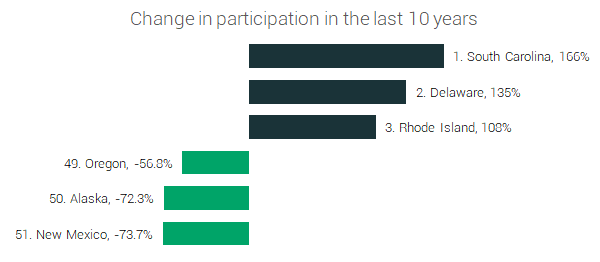
On the other hand, participation in 24 states has declined. It has declined most in Oregon, Alaska and New Mexico.
Full rankings - change in participation
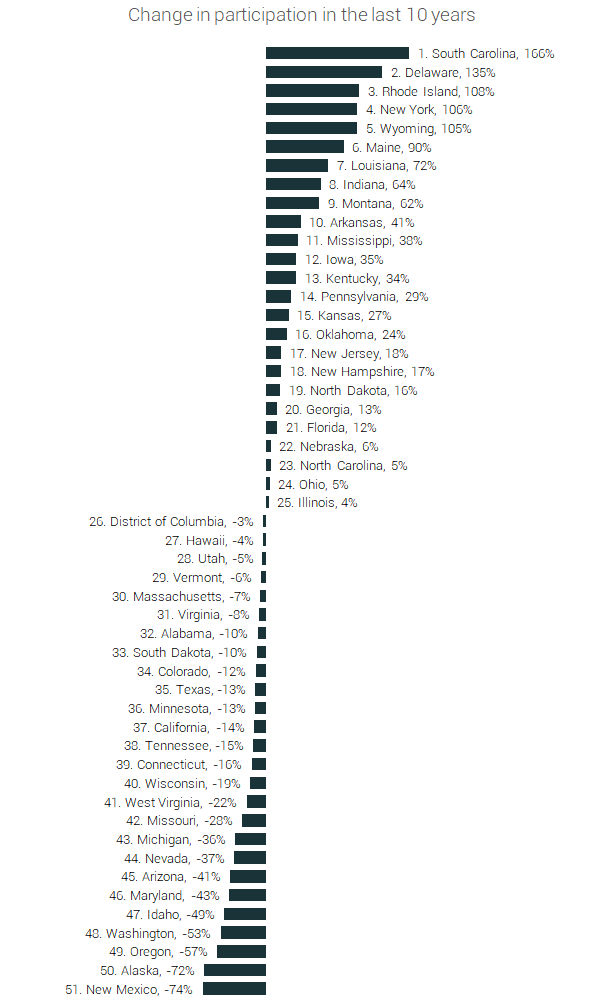
It is also interesting to note the gender distribution of the participants by state. Florida and Illinois are the states with most female marathon runners. In these states, there are actually more female than male marathoners.
The state with the lowest proportion of women is Nebraska - 35.6%. This is actually higher than the world's average of female participation.
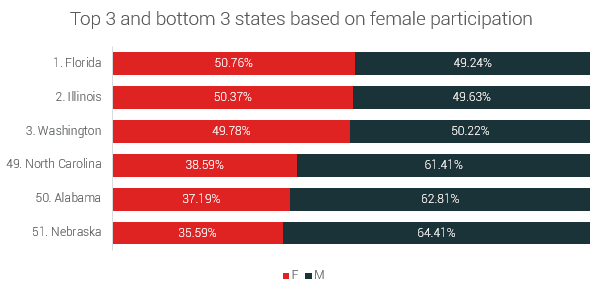
Full rankings by gender distribution
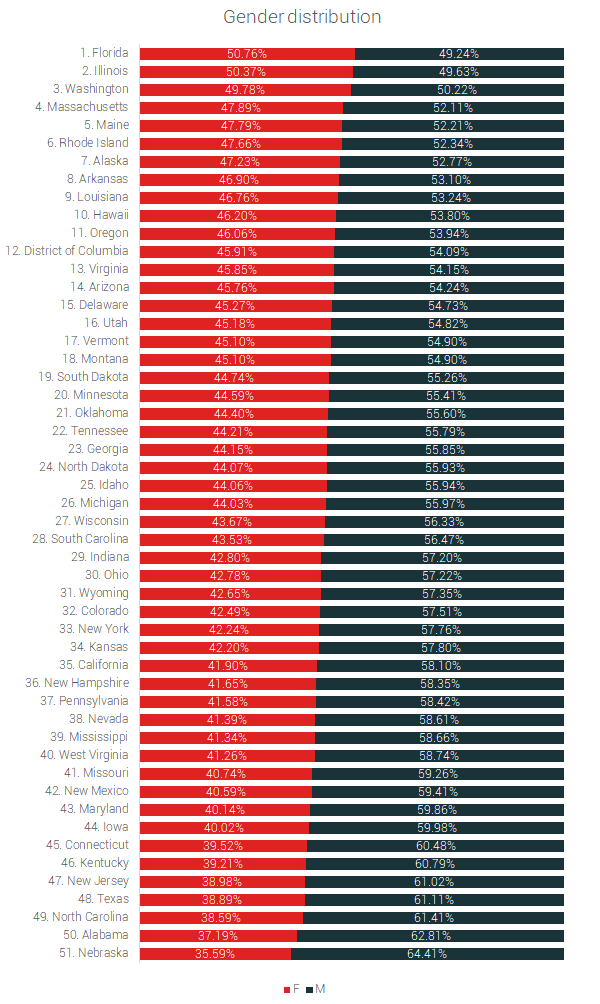
Age of participants
The state with the youngest participants, on average, is Massachusetts and they are also the fastest. But still, the second and third fastest states are not among the youngest. We see that even though age does play a role in the average finish time, it's only one of many factors
The average age of the US marathoner for comparison is 39.66.

Full rankings by average age
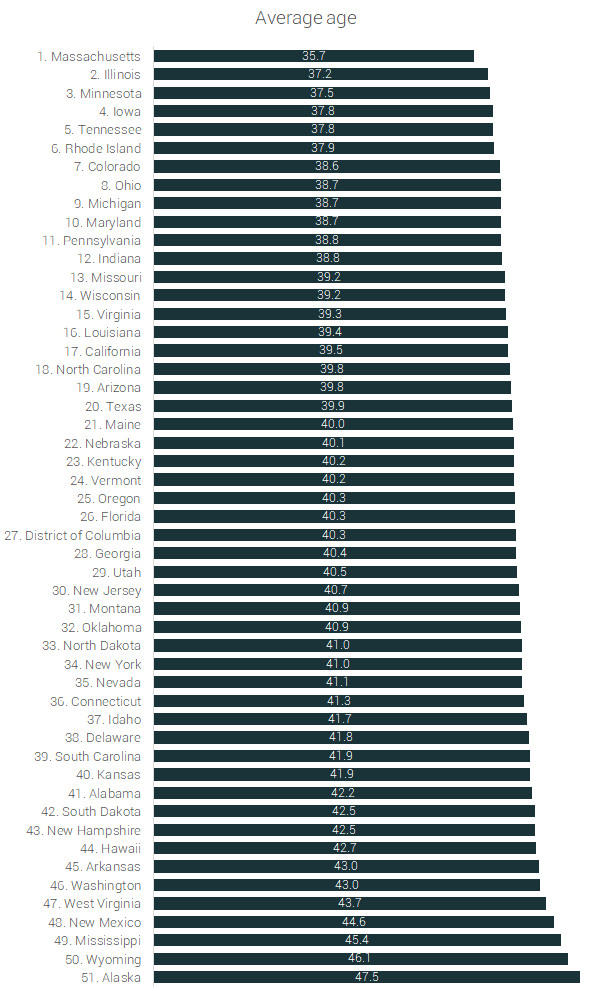
There is a significant difference between the average age of male and female participants. In general female races are younger. And the youngest ones are again from Massachusetts.
The average age of the American female marathoner is 37.91 years, for comparison.
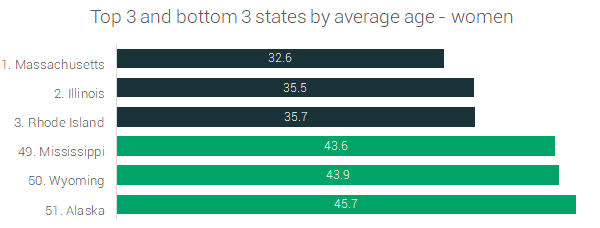
Full rankings by average age - women
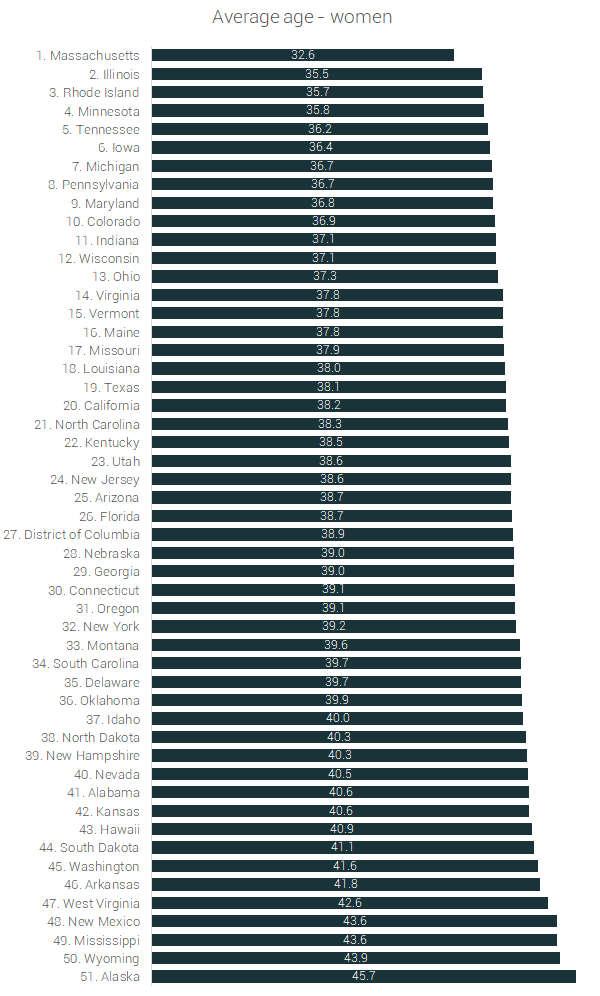
Men are on average 5 years older than women on a state by state basis. The youngest men are also from Massachusetts, but they are with an average age of 38.5 years, which is 5.9 years older than women.
The average age of male marathoners in the US is 41.05 years.
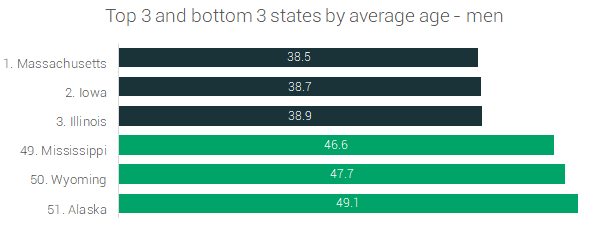
Full rankings by average age - men
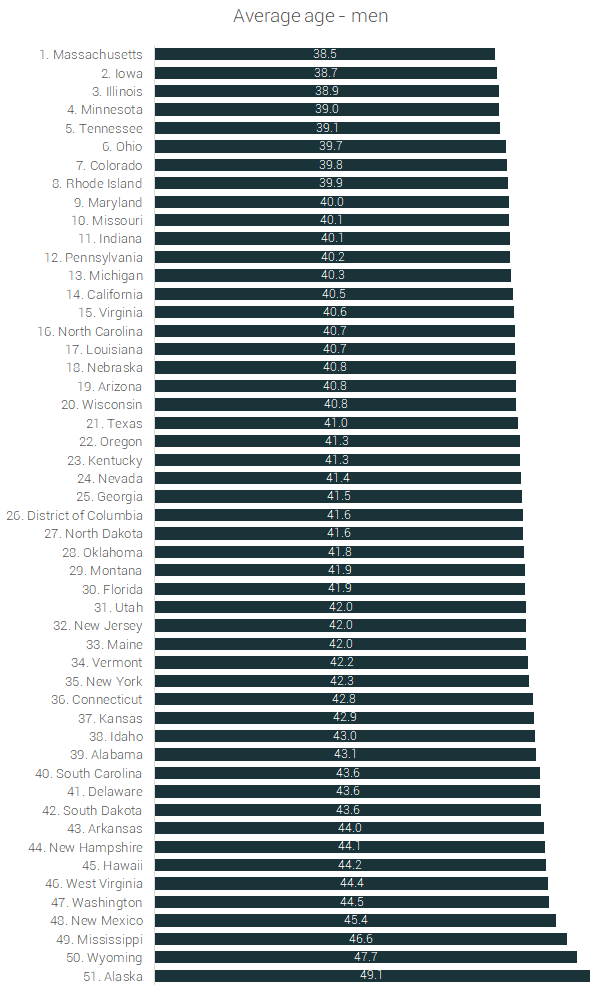
The average ages of the participants have changed over the last 10 years. In Massachusetts, the average age has declined by 5 years, and in Alaska, it has increased by 8.2 years (and now Alaska is the state with the oldest participants in the US).
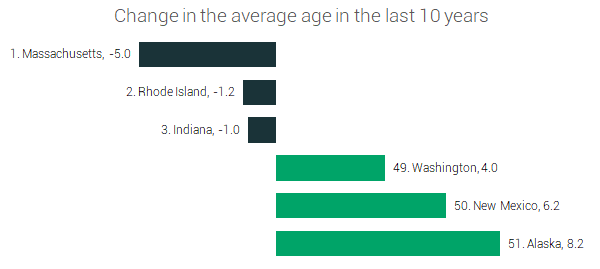
For most states (42 of them) the average age of participants has increased.
Full rankings by the change in average age
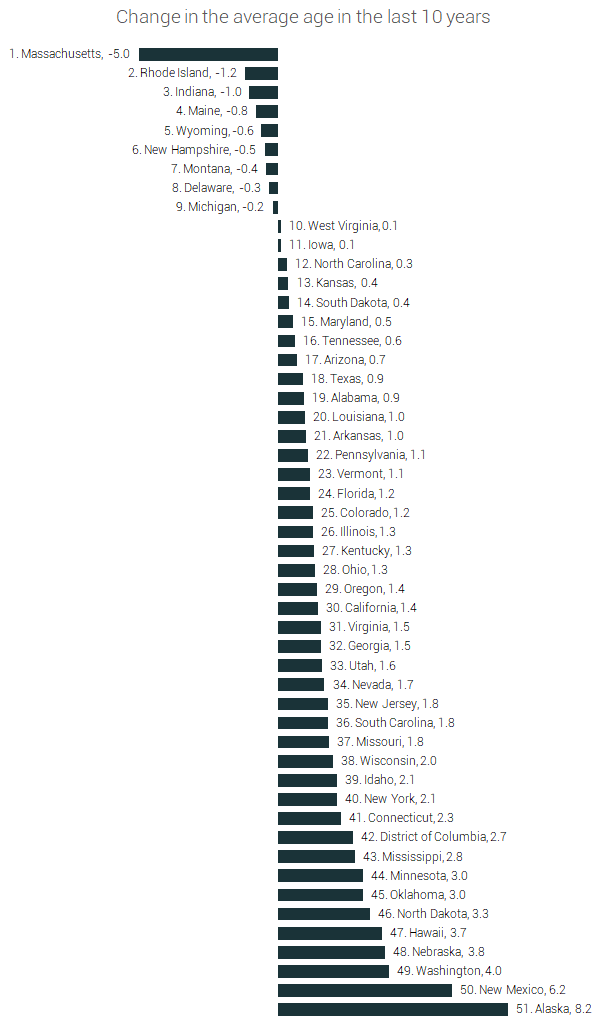
State Reports
In this section, we provide a summary for each state (+ Washington D.C.) and how its marathon performance has changed over the last 15 years. Click on the name of the state to see each report.
Massachusetts #1 - the fastest state
Massachusetts is the fastest state in the US, and it has both the fastest men and the fastest women in the US. Being the fastest state in the country is not preventing runners from slowing down through the years though. Over the last 10 years, the runners from Massachusetts have slowed down on average by 13 minutes (5.5%).
Women have slowed down slightly more than men here. Women have added 12 minutes to their average finish time (5%) and men - 11 minutes (5%).

Massachusetts women have an average finish time of 4 hours 15 minutes 1 second, which makes them faster than the men from 36 states + D.C. They include - New York, California, Nevada, Vermont and many many more.
Massachusetts is #4 by the proportion of women in 2018. As we can see there has been a stable increase in female participation - an increase of 11% over the last 15 years.

Massachusetts is #2 by the change in average age. The average age of Massachusetts marathon runners has fallen by 5 years. Women's average age has decreased more than that of men. The average age of women has decreased by 5.2 years, and the average age of men - by 4.1 years.
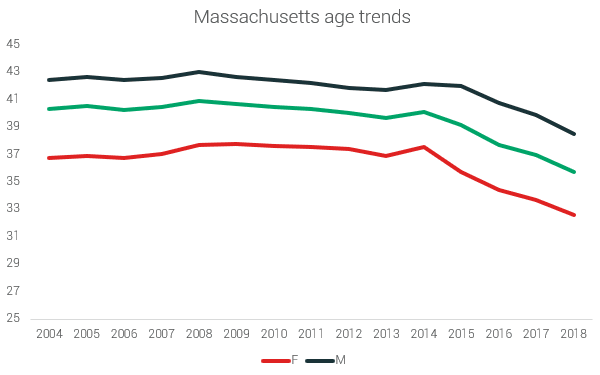
In Massachusetts, there is a sharp increase in participants under 40 years old. And it's interesting to note, that there is a shrinking in the proportion of the participants in their 40s. The % of participants over 50 are staying quite stable.
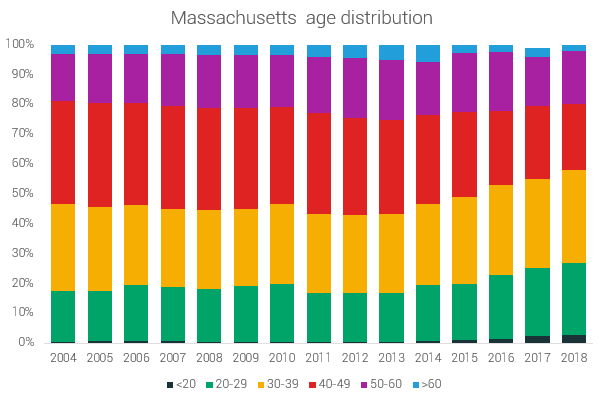
In Massachusetts, just the youngest participants have become faster over the last 15 years - by 23 minutes (8%). All other age groups have slowed down. The participants in their 20s have slowed down by 20 minutes 30 seconds (8%). The ones in their 30s - by 29 minutes (12%), the ones in their 40s - by 14 minutes (5%), the ones in their 50s - by 6 and a half minutes (2%). And the oldest participants have slowed down by 11 minutes (4%).
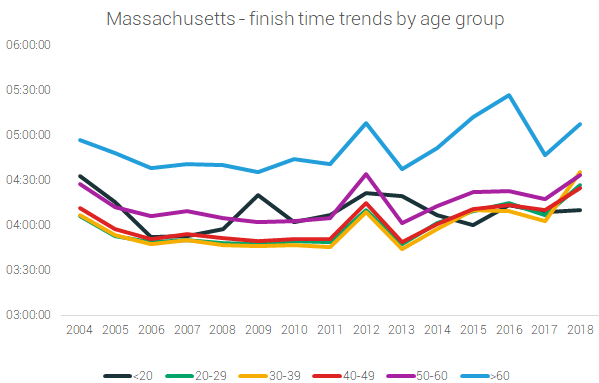
Why are Massachusetts Runners so fast?
Where the numbers don't always explain everything, we can look at the people on the ground to add some context. Here's what Meg Reilly from the BAA (organizers of the Boston marathon) had to say:
"At the B.A.A., we take pride in runners of all paces and from all places, but of course we love being able to inspire our hometown heroes right here in the Commonwealth. As you know well, for more than a century, the Boston Marathon has been a unifying and motivating event in the Massachusetts community. The Boston Marathon has routinely served as inspiration to Massachusetts citizens to get active and run: each year’s race exposes more and more people to the powerful impact of running and the competitive side of the sport. Finishers of the Boston Marathon are celebrated and recognized in communities across the state and our participants give back to their local communities.
The Boston Marathon is held just as the signs of spring are beginning to unfold in New England and is an impetus for all residents get outside and run, even if they aren’t making the 26.2 mile trek. In recent years, more than 4,000 Massachusetts residents have participated in the Boston Marathon each year, with tens of thousands more participating in the B.A.A.’s other signature events throughout the calendar year. The exposure to elite competitions and fast runners is definitely one reason as to why Massachusetts is a fast place to be. As experienced marathoners know, qualifying for the Boston Marathon continues to be a highly competitive endeavor. Our neighbors and communities train through all conditions to make it to our starting line in April and we are continually awed by their accomplishment and achievements. Training and racing in Massachusetts is not for the faint of heart – the grit, strength, and commitment of our athletes is as well represented at the marathon distance as in any other.
There are other factors that make Massachusetts such a great – and fast – running community: two of which are the locale and running club community. Whether in the city or suburbs, there are countless running paths or trails to experience every day. Beyond training, every weekend there are dozens of road races throughout the community spanning distances from the mile to marathon, including our own B.A.A. 5K in April, B.A.A. 10K in June, and B.A.A. Half Marathon in October.
For decades the Massachusetts running club community has been very competitive, too. In the 1970s and 1980s, the B.A.A. and Greater Boston Track Club (especially 4-time Boston Marathon champion Bill Rodgers) helped ramp up America’s running boom from right here in Boston, and showcased how this area is a great place to train and race. Today, the B.A.A.’s High Performance team boasts elite athletes competing on and off the track and representing our country in top competition. Our very own B.A.A. Running Club boasts hundreds of members, including Olympic Trials qualifiers, Team USA representatives, and Boston Marathon finishers. The B.A.A. regularly looks to work with communities to introduce individuals of all ages to the sport of running – and we love to see the children we reach through our community engagement grow up to be runners in college and adulthood!"
Washington #2 - the second fastest state
Washington is not only the 2nd fastest state in the country, but it's also the #3 most improved state in the last 10 years. Overall Washington marathoners have decreased their average finish time by 15 and a half minutes.
Here women have improved more than men. Women have decreased their average finish time by 20 minutes (-6.7%) and men by 13 minutes (-5.1%).
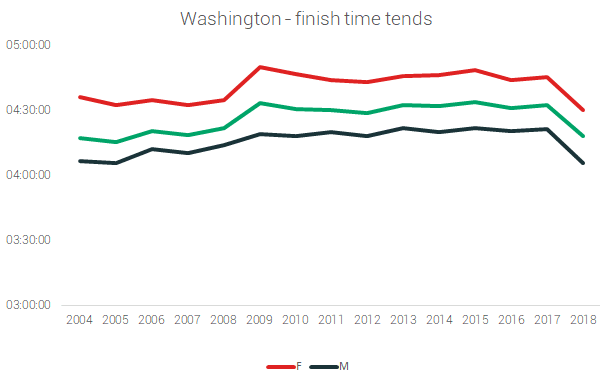
What we can see from the graph is that there was a slight slow down of Washington participants until 2017. The average slow down was 6.4% from 2004 to 2017. But then, just for 2 years, Washington runners have returned to their average finish times from 15 years ago.
If we take the 15-year time frame, women have improved by 6 minutes on average (-2.2%), and men by less than a minute.
Washington today is the state with the #3 biggest proportion of female marathoners. And it has just under 50% female participation - 49.78% to be exact. And also, Washington is one of the states with the biggest growth in female proportion over the last 15 years - a growth of 14%.

In Washington, the average age of participants has risen by 4 years over the last 10 years. Which ranks them among the 3 states with the highest increase in the average age of marathoners. Here, as in most states, the female average has grown more. For women, the average age has increased by 4.6 years and for men by 3.7 years.
It is also interesting to note, that in 2004 the gap between the average female and the average male age was about average - 5.4 years, but it has shrunk quite a bit. And today it's just 3 years.
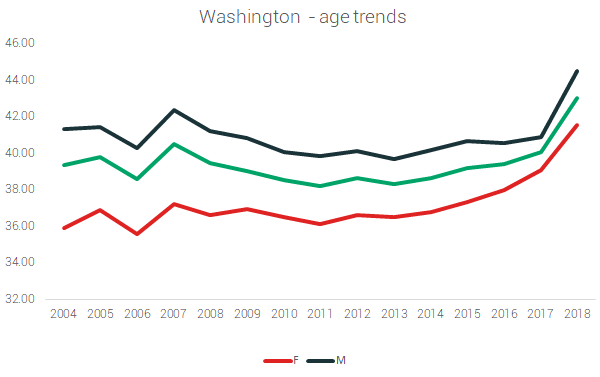
The increase in the average age of marathoners is reflected in the age distribution. We can clearly see a decline in the % of participants under 40. And an increase in the % of participants in all 3 older age groups. We can see that in 2018, the participants over 40 make up close to 60% of the total participants.

In the last 15 years, most of the age groups have improved slightly. The youngest participants have shaved off 6 minutes (2.2%) from their average finish time. The participants in their 20s have become faster by 4 minutes (1.6%). The participants in their 30s - by 5 and a half minutes (2.2%). The participants in their 40s have decreased their finish time by just under a minute (<1%). The participants in their 50s have improved by 1 and a half minutes (<1%). And the oldest participants are the only ones who have slowed down - by 20 minutes (6.8%).

Indiana #3 - the third-fastest state
Indiana is the third-fastest state, with the #3 fastest men and #11 fastest women. And on top of that Indiana is one of the states which have improved over the last 10 years. Overall Indiana runners have improved by 1 minute and 20 seconds (<1%). And Indiana is one of the few states where men have improved more than women. Women have improved with a bit more than a minute (0.5%), but men have shaved 5 minutes off their average time (2%).
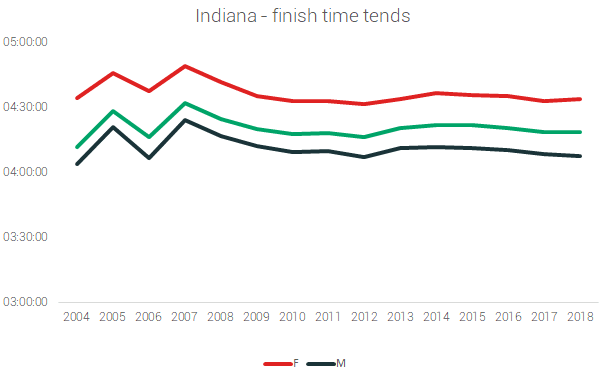
Indiana has slightly below average % of women now, but it has gone a long way. An 18% increase in female proportion is huge, and it's one of the biggest changes in the country.

Indiana is one of the 9 states which average age has decreased over the last 10 years. And Indiana is the #3 state by this criterion.
Both men and women have a decreased average age. For women, the average has decreased by 0.4 years and for men - 0.9 years.
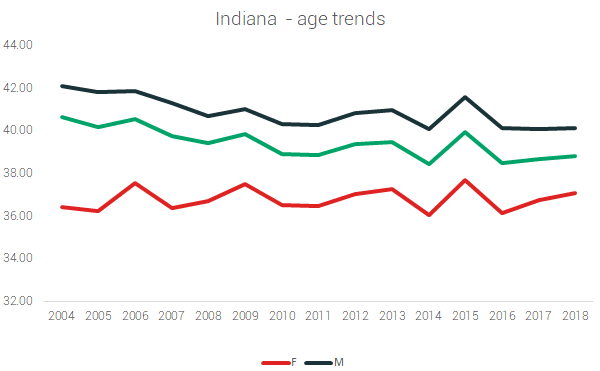
In Indiana, the age distribution has stayed quite stable. What we see is a slight increase in the participation of the youngest participants and a shrinking of the participation of the 20 year-olds.
And also there is a slight increase in participation from the participants in their 50s.
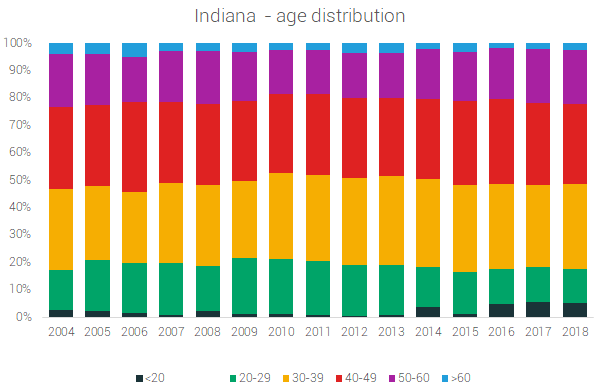
In this break down we see that surprisingly all age groups have slightly slowed down in the last 10 years.
The youngest participants have added 12 minutes (5%) to their finish time. The participants in their 20s have slowed down by 2 minutes (<1%), the ones in their 30s - by 5 minutes (2%), the ones in their 40s - by 11 and a half minutes (4%) and the ones in their 50s - by 10 minutes (4%). The oldest participants have slowed down most - by 26 minutes (9%).
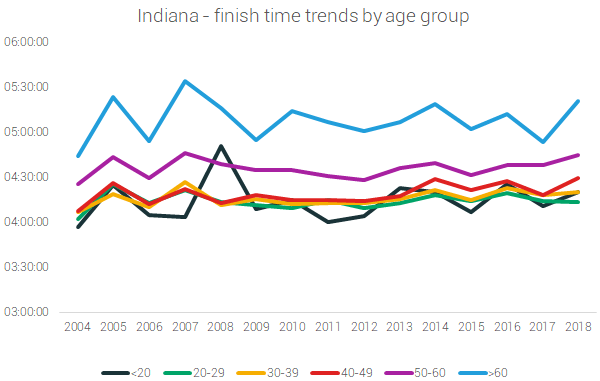
Alaska
Even though Alaska is among the slowest states in the country, it is one of the states which have improved over the last 14 years. Regrettably, we see that there is a considerable slow down in the last year.
Over the whole period, the overall finish time has increased by 40 seconds (0.2%). Women have become 3 minutes 28 seconds faster (improvement of 1%), and men have become 23 minutes slower (23%).

If we take a look at the last 10 years - the overall finish times have increased by 31 minutes (10%). The men in Alaska are the ones who have slowed down the most in the last 10 years - by 39 minutes (14%). Women have slowed down much less than men in this state - by 24 and a half minutes (8%).
Alaska is among the states with a higher proportion of female participants. Even though 47% is among the highest in 2018, we see that it has declined from 63% in 2004. So Alaska is experiencing a decline in female participation.
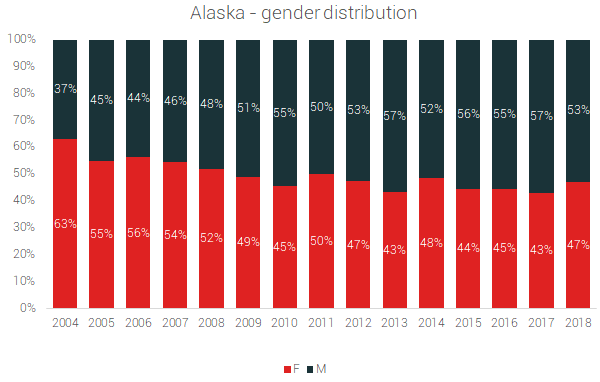
In Alaska, the average age of the participants is skyrocketing. The overall average age has risen by 12.9 years. For women, it has risen by 12.4, and for men by 12.3 years. Which makes Alaska the state with the oldest participants in 2018. It is also the state with the biggest increase in average age over the last 10 and over the last 15 years.
The change in average age in the last 10 years is as follows - an overall increase of 8.2 years, for men - and increase of 9 years and for women - an increase of 7.1 years. Alaska is one of the few states where the average male age has increased more than the average female age.
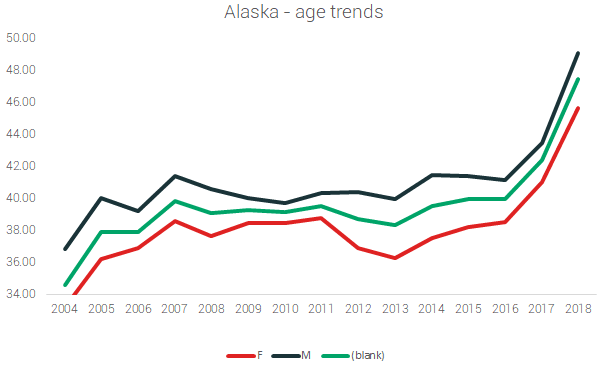
We can see why that is on the chart below. In Alaska, there is a steady decline in the % of participants under 40 and a stable increase in the % of participants over 50.
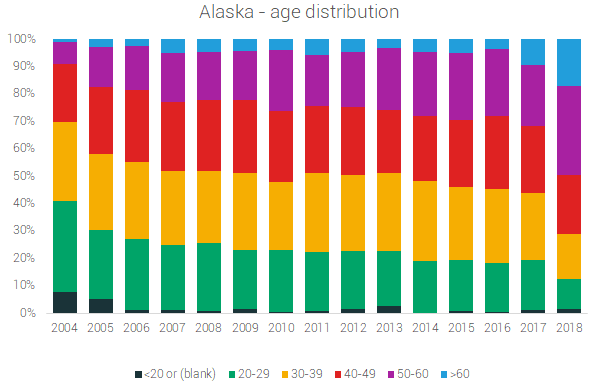
It is also quite interesting that most age groups have kept stable finish times over the last 15 years, except the ones over 60.
The participants under 20 have become faster by 53 minutes (an improvement of 17%). The participants in their 20s have also become faster - by 27 minutes (9%). The participants in their 30s have also become faster - by 29 minutes (9%).
Too bad that these age groups are shrinking, and they can't offset the slow-down of the older participants.
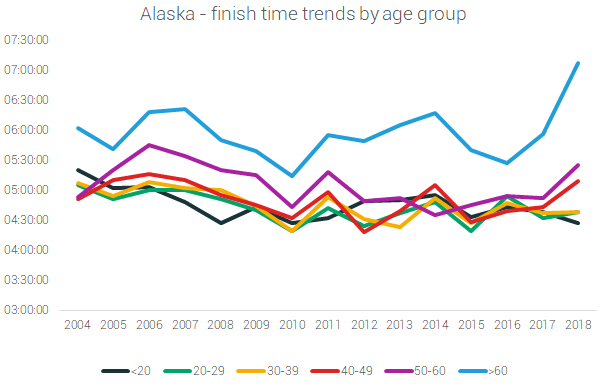
The participants in their 40s have slowed down by 18 minutes (6%), the ones in their 50s by 33 minutes (11%), and the ones over 60 have added more than 1 hour to their finish time (a slow down of 18%).
Florida
Florida is the second slowest state in the US. And also it's the most slowed down state in the country. The average finish time here has increased by 40 minutes 20 seconds (14%) over the last 10 years. Women have slowed down more than women in this state. Women have increased their finish time by 41 minutes (13%) and men have slowed down by 36 minutes (13%).
Also, Florida women, are the ones who have slowed down the most in the country.
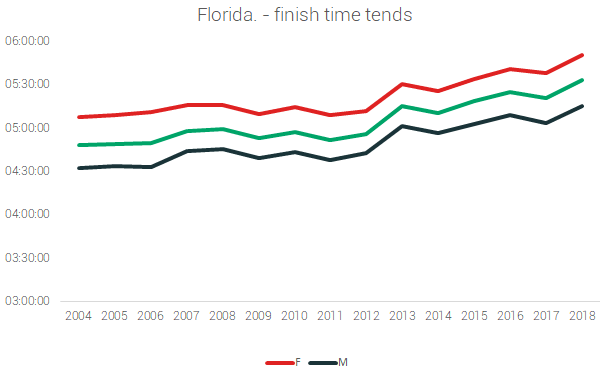
Also, Florida is the state with the biggest % of women in the US in 2018.
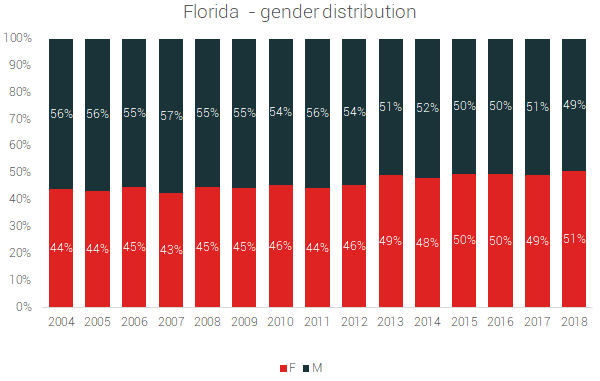
Florida marathoners are getting older. Over the last 15 years, the average age of participants has risen by 1.4 years. Like in most other states female average age is rising faster than the male. For women, the average age has risen by 2.6 years, and form men - by 1 year.
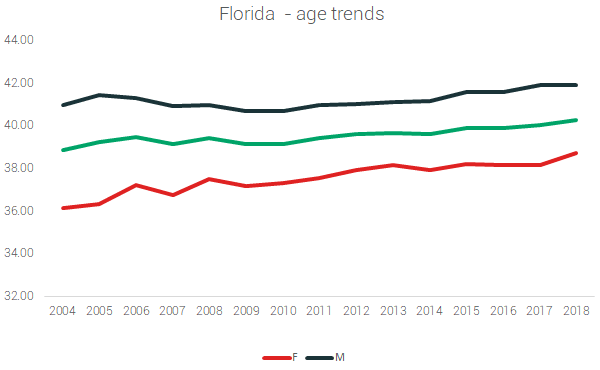
In Florida, the age distribution of participants has stayed quite stable over the years - with just a slight decrease in participants in their 30s and a slight increase in participants in their 50s.
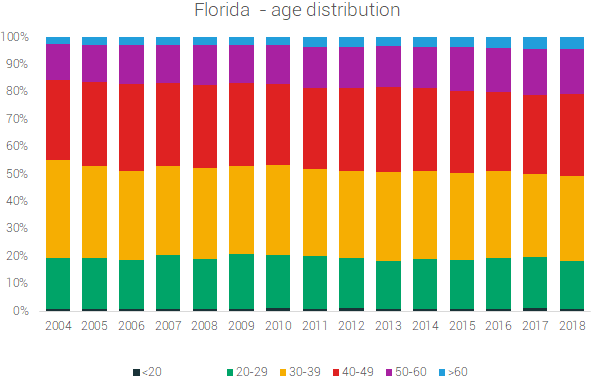
In Florida, all the age groups are slowing down. Over the last 15 years, the youngest participants have slowed down by 44 minutes (16%). The participants in their 20s have slowed down by 42 minutes (15%). The ones in their 30s have added 44 minutes (16%) to their average time and the participants in their 40s have slowed down by 46 minutes (16 minutes).
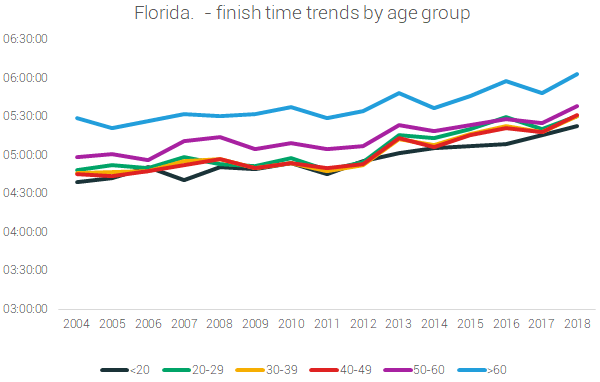
The participants in their 50s have slowed down by 40 minutes (13%). And the oldest participants have added 34 minutes (10%) to their average finish time.
It's interesting to see that in Florida, the older participants have slowed down less than the younger ones.
Hawaii
Hawaii is the slowest state in the country. And the runners from Hawaii are the second most slowed down in the last 10 years.
Overall the average finish time of Hawaiians has risen by 38 minutes (11%). Women have slowed down less than men. Women have added 37 minutes (10%) to their average finish time and men have added 38 minutes (12%) to their time.
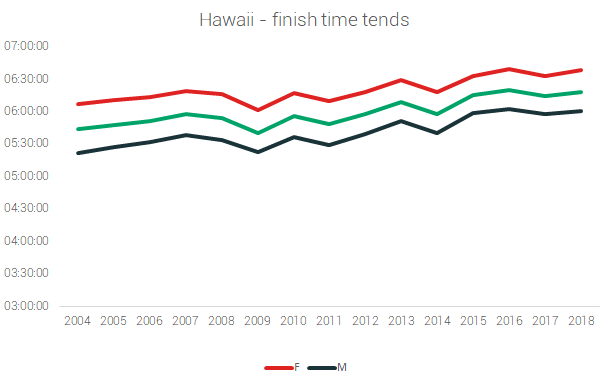
In Hawaii, the average age of participants is going up. In the last 10 years, the average age of participants has risen by 3.7 years (10%), which ranks Hawaii at #47 by the change in average age. As with most of the states the average female age has risen more than the males. For women, there is an increase of 4 years and for men and increase of 3.6 years.
If we look at the 15-year time frame, the average age of participants has risen by 4.1 years (5 for women and 3.1 for men).
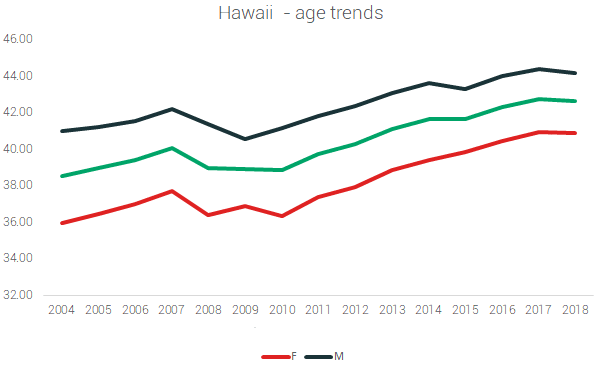
In Hawaii, we see a significant decrease in participation from runners under 40. Also there is a slight increase in the % of participants in their 40s and the ones over 60. But the biggest increase is in the participants in their 50s. Their proportion has doubled from 2004 until now.
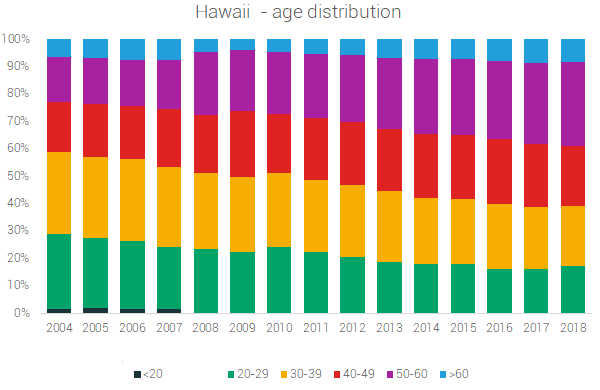
Here it's interesting to note that in the last 15 years most age groups have improved. But the change in age distribution has produced an increase in overall finish times. In the last 15 years, the youngest participants have lost 38 and a half minutes (11%) from their finish times. The ones in their 20s - 53 minutes (15%), the ones in their 30s - 34 and a half (10%) and the ones in their 40s - 25 and a half (8%).
The participants with the biggest increase in participation are slowest and have improved the least - the participants in their 50s have improved by 4 minutes (1%) and the participants over 60 - by 3 minutes (<1%).
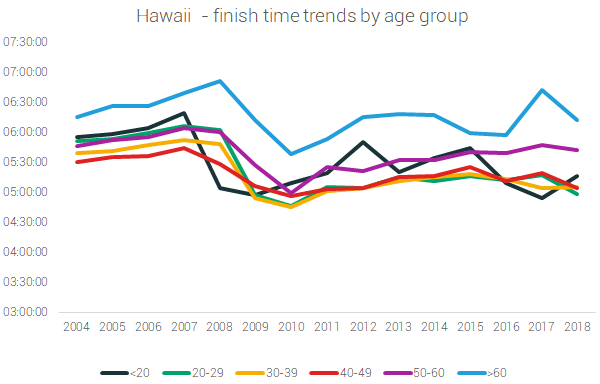
If we look at the last 10 years, then we see that most of the age groups have slowed down a bit. the youngest participants have added 19 minutes (7%) to their average finish time, the participants in their 20s have added just 1 minute (<1%), and the participants in their 30s have added 11 minutes (4%).
The participants in their 40s are the only ones who have improved over the last 10 years - by 1 and a half minute (<1%). The participants in their 50s have slowed down by 15 minutes (5%) and surprisingly the eldest participants have added just 5 seconds to their finish time.
Methodology
- The data covers 96% of US race results.
- Elite runners have been excluded and thus this is an analysis of recreational runners.
- Walks and "walk/run for charity"-events have been excluded as well as obstacle course races and other non-traditional running events.
- Events with less than 500 participants have also been excluded.
- 19.6 million race results, over 30,000 events
- From 2004 to 2018.
About The Researchers
The lead in this study is Danny McLoughlin. He was assisted by Vania Andreeva Nikolova, Ph.D. in Mathematical analysis.
Boost Your State Rankings
There are a bunch of ways you can bump your state up in the rankings.
It doesn't matter how fast you are, just by taking part in a competitive marathon you're at least helping your state with the participation numbers. You can sign up for marathons in all the major cities. The Chicago Marathon (sponsored by Nike), The Boston Marathon (sponsored by Adidas), The LA Marathon (sponsored by ASICS) or The New York Marathon (sponsored by New Balance.)
Outside of the state rankings, the most important thing is to get active. If you don't want to, you don't even have to sign up for a competitive event. Maybe you just want to get outside and start walking. You can even grab your Hiking boots, shoes or sandals and you can get out for a walk.
Use of content
- We are happy to give interviews on the topic at any time. Reach out to Danny at danny@runrepeat.com.
- For web usage, any minor text sections, all data, and all graphics may be used as long as a reference is added to this original piece.
- For print usage, reach out to danny@runrepeat.com.
